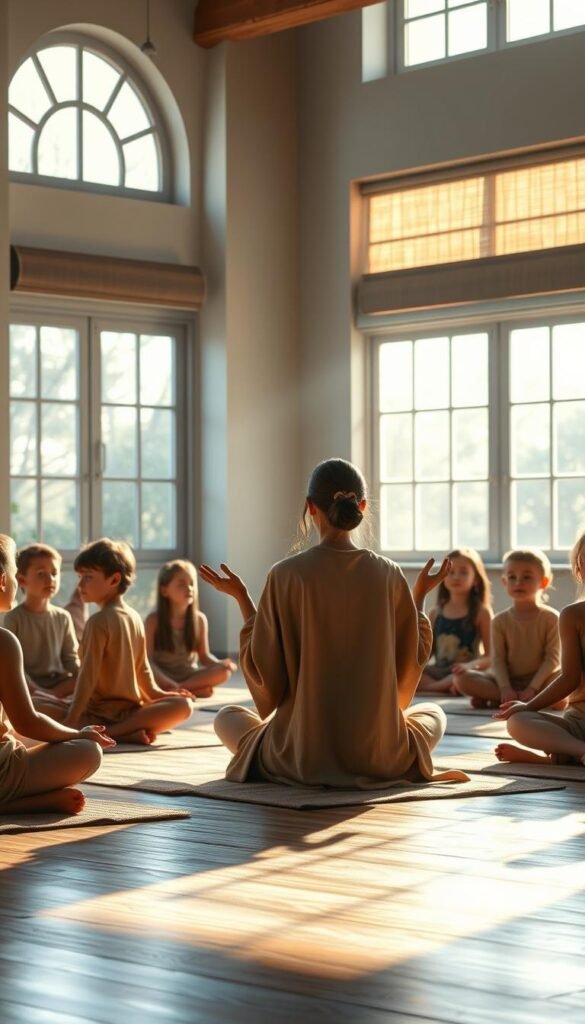In today’s fast-paced world, learners face constant distractions. From digital devices to academic pressures, staying focused can feel like an uphill battle. Mindfulness offers a way to navigate these challenges by helping individuals connect with the present moment.
This practice isn’t just about relaxation; it’s a skill that enhances cognitive performance and emotional resilience. By training the mind to stay attentive, students can improve their ability to absorb and retain information. Think of it as mental muscle training—building strength for sustained focus.
Modern education emphasizes not only academic achievement but also social-emotional development. Research from CASEL highlights how mindfulness supports self-regulation, a key skill for success in school and beyond. By integrating this practice into daily routines, learners can thrive in both their studies and personal lives.
Key Takeaways
- Mindfulness helps students stay focused and present in their learning experiences.
- It builds emotional resilience and cognitive performance.
- Think of mindfulness as mental muscle training for sustained attention.
- CASEL research links mindfulness to improved self-regulation skills.
- Modern education values both academic and social-emotional growth.
1. Introduction to Mindfulness for Students
Modern classrooms are filled with distractions that pull attention in multiple directions. From digital devices to peer interactions, staying focused can feel overwhelming. This is where mindfulness steps in—a practice that helps individuals connect with the present moment.
According to the Greater Good Science Center, mindfulness is defined as “awareness and acceptance of internal and external experiences.” It’s about noticing what’s happening right now without judgment. For children, this skill can be transformative, helping them navigate the challenges of school and life.
What is Mindfulness?
Mindfulness isn’t just about sitting still or meditating. It’s a way of training the mind to stay attentive and aware. Research from the Mindfulness in Schools Project shows that regular practice can lead to structural changes in the brain, strengthening attention networks.
One student shared, “I notice when my mind wanders during tests now.” This self-awareness is a key benefit of mindfulness. It helps learners break free from autopilot modes and engage more deeply with their studies.
Why Mindfulness Matters in Education
Teaching mindfulness in schools isn’t just a trend; it’s backed by science. A 2005 study found a 24% improvement in focus among elementary students who practiced mindfulness. The CASEL framework also highlights its role in building self-awareness and self-regulation—skills essential for academic and personal success.
One simple technique is the “STOP” method: Stop, Breathe, Observe, Proceed. This tool helps children manage emotions and stay grounded during stressful moments. Teachers report calmer classrooms, with 68% noting significant improvements in student behavior.
By integrating mindfulness into daily routines, schools can create environments where children thrive. It’s not just about better grades—it’s about nurturing well-rounded, emotionally resilient individuals.
2. The Benefits of Mindfulness for Students

In a world filled with constant demands, staying present can feel like a challenge. Mindfulness offers a way to navigate these pressures, providing tools to enhance focus, reduce stress, and build emotional resilience. These benefits aren’t just theoretical—they’re backed by science and practical strategies. By incorporating mindfulness practices into daily routines, individuals can cultivate a greater sense of control and well-being. Mindfulness research insights reveal that even short, regular sessions can significantly improve mental clarity and emotional health. As these practices become ingrained, they not only enhance personal resilience but also foster deeper connections with others.
Improved Focus and Attention
Research from Davidson & Lutz shows that mindfulness can lead to cortical thickening in the brain, strengthening attention networks. This means better focus during tasks like studying or taking tests. A 2015 study in the Journal of Adult Education found a 17% GPA improvement among ADHD students who practiced mindfulness regularly.
One effective technique is the “Name It to Tame It” strategy. By identifying emotions as they arise, individuals can regain focus and clarity. This simple tool helps break the cycle of distraction, making it easier to stay on track.
Reduced Stress and Anxiety
Stress is a common challenge for learners, but mindfulness can help. The Napoli 2005 study found a 30% reduction in stress levels among K-5 students who practiced mindfulness. Paced breathing techniques lower cortisol levels, promoting a sense of calm.
Middle schools have started using 5-minute breathing breaks before exams to help students manage test anxiety. These small pauses can make a big difference, creating a more relaxed and focused mindset.
Enhanced Emotional Resilience
Mindfulness also builds emotional resilience, helping individuals bounce back from challenges. Activities like “Glimmer Hunting”—noticing small moments of joy—can shift focus from stress to positivity. This practice strengthens the prefrontal cortex, which regulates emotions.
High school students have found journal prompts like “When I feel overwhelmed, I…” to be helpful. Writing about emotions fosters self-awareness and provides a healthy outlet for stress. These tools empower learners to handle life’s ups and downs with greater ease.
3. How Mindfulness Supports Social-Emotional Learning
Emotional growth is just as vital as academic success in shaping young minds. Social-emotional learning (SEL) equips children with the tools to understand and manage their emotions, build relationships, and make thoughtful decisions. Mindfulness practices enhance these skills by fostering self-awareness and self-regulation.
Research from the Feuerborn 2019 review highlights that mindfulness boosts all five CASEL SEL competencies. These include self-awareness, self-management, social awareness, relationship skills, and responsible decision-making. By integrating mindfulness into daily routines, schools can create environments where children thrive emotionally and academically.
Self-Awareness and Self-Regulation
Self-awareness is the foundation of social-emotional learning. It involves recognizing one’s emotions and understanding how they influence behavior. Mindfulness practices, such as the “Emotion Weather Report,” help children identify their feelings in real-time. This simple check-in ritual encourages them to pause and reflect.
Self-regulation, on the other hand, is the ability to manage those emotions effectively. Techniques like paced breathing and the “STOP” method (Stop, Breathe, Observe, Proceed) teach children to respond rather than react. The Benn 2012 study found a 40% reduction in conflicts in special education classrooms where mindfulness was practiced regularly.
Building Stronger Peer Relationships
Mindfulness also plays a crucial role in fostering empathy and connection among peers. Activities like “Buddy Breathing” encourage children to synchronize their breathing with a partner, promoting a sense of shared calm. This exercise builds trust and understanding, essential for healthy relationships.
Another effective tool is the conflict resolution script: “I feel…when…because…” This structured approach helps children express their emotions clearly and resolve disagreements constructively. By practicing these skills, they learn to navigate social dynamics with confidence and compassion.
| Activity | Purpose | Outcome |
|---|---|---|
| Emotion Weather Report | Identify feelings | Increased self-awareness |
| Buddy Breathing | Build empathy | Stronger peer relationships |
| Conflict Resolution Script | Express emotions | Improved communication |
4. Mindfulness Activities for the Classroom

Engaging activities can transform learning environments into mindful havens. These mindfulness activities help children stay grounded, focused, and aware of their surroundings. By incorporating simple exercises, educators can create a calm and productive classroom atmosphere.
Heartbeat Exercise
The Heartbeat Exercise is a simple yet powerful way to connect with the body. Ask children to place their hands over their hearts and feel their heartbeat. This practice, often called “Biofeedback 101,” helps them become aware of their physical sensations. Research from the Cleveland Clinic shows that such activities can reduce stress by lowering cortisol levels.
- Guide students to close their eyes and focus on their heartbeat.
- Encourage them to notice changes in rhythm as they breathe deeply.
- Use this exercise before tests to promote calmness.
Pinwheel Breathing
Pinwheel Breathing is a fun way to teach children about the power of breath. Give each child a pinwheel and ask them to blow on it slowly. For students with asthma, substitute the pinwheel with a feather visualization. This activity helps regulate breathing and promotes relaxation.
- Provide pinwheels or ask children to imagine holding one.
- Instruct them to take deep breaths and blow gently.
- Discuss how controlled breathing can calm the mind.
Five Senses Exercise
The Five Senses Exercise, inspired by Berkeley’s raisin protocol, enhances sensory awareness. Ask children to focus on one sense at a time—what they see, hear, smell, taste, and touch. Create “Sensory Detective” kits with textured objects for ADHD learners to make this activity more engaging.
- Provide objects like smooth stones, scented candles, or soft fabrics.
- Guide students to describe each sensation in detail.
- Use this exercise to help them stay present and attentive.
By integrating these mindfulness activities into daily routines, educators can foster a supportive and focused learning environment. These exercises not only enhance academic performance but also nurture emotional well-being.
5. Teaching Mindfulness to Kids: Tips for Educators

Creating a calm and focused learning space starts with intentional practices. Educators play a vital role in helping children connect with the present moment. By integrating mindfulness into daily routines, teachers can foster an environment where kids thrive academically and emotionally.
Creating a Mindful Classroom Environment
Designing a mindful classroom begins with simple yet effective tools. One approach is to introduce Attention Anchors—objects like a small bell or a calming image that help students reset their focus. These anchors serve as gentle reminders to pause and breathe, especially during transitions.
Another strategy is to incorporate transition rituals. For example, using bell chimes to signal subject changes can create a sense of rhythm and calm. According to the Smiling Minds app, 82% of teachers reported higher satisfaction when such practices were implemented.
Incorporating Mindfulness into Daily Routines
Mindfulness doesn’t have to take up much time. The Leland 2015 study found that even a 12-minute daily practice can sustain long-term benefits. Start with micro-practices, like taking three deep breaths between lessons. This simple habit helps both teachers and students reset their focus.
Another engaging activity is the Gratitude Globe. Each day, students share something they’re thankful for, fostering a positive classroom culture. This practice not only builds emotional resilience but also strengthens peer connections.
Addressing implementation challenges is key. Gaining administrator buy-in can ensure the program’s success. For example, PS 89 embedded mindfulness into their schedule without losing instructional time, proving it’s both practical and impactful.
6. Mindfulness for Students with Learning Disabilities

Children with learning disabilities often face unique challenges in traditional educational settings. These challenges can include difficulty focusing, sensory overload, and emotional regulation struggles. Mindfulness offers a way to support these students by fostering self-awareness and calmness.
Benefits for ADHD and Special Needs
For students with ADHD, mindfulness can be transformative. A 2015 study in the Journal of Adult Education found a 22% improvement in behavior among ADHD students who practiced mindfulness regularly. This practice helps them stay present and manage distractions more effectively.
Children with special needs also benefit from mindfulness. It provides tools to handle sensory processing challenges and emotional overwhelm. For example, the UC Davis MIND Institute has developed adapted body scan protocols that cater to individual needs, making mindfulness accessible to all.
Adapting Mindfulness Practices
To make mindfulness effective for students with learning disabilities, practices must be tailored. Here are some strategies:
- Fidget-to-Focus: Use tactile meditation tools like stress balls or textured objects to help students stay grounded.
- Modified Breathing: Adapt breathing exercises for sensory processing disorders by using visual cues or shorter durations.
- Spotlight Scanning: Train aides to guide overstimulated students through focused attention techniques.
Incorporating mindfulness into Individualized Education Programs (IEPs) can also be impactful. Setting specific benchmarks, such as “student will use paced breathing during transitions,” ensures measurable progress.
Partnering with occupational therapists can further enhance mindfulness integration. For instance, proprioceptive activities like weighted blankets or movement breaks can complement mindfulness practices, creating a holistic approach to learning.
7. Group Mindfulness Activities for Students
Collaborative practices can transform the way students engage with their surroundings. Working together fosters a sense of connection and focus, making learning more meaningful. These group mindfulness activities are designed to build awareness, teamwork, and emotional resilience in the school environment.
Mindfulness Bingo
Mindfulness Bingo is a fun and interactive way to introduce awareness practices. Students complete tasks like “Take three deep breaths” or “Notice something new in the room.” This game encourages them to stay present while fostering a sense of accomplishment.
CASEL’s 2021 report highlights the benefits of cooperative mindfulness, showing improved focus and social skills. Teachers can adapt Bingo cards to align with themes like gratitude or kindness, making it a versatile tool for any classroom.
Nature Walks and Sensory Games
Taking learning outdoors can have a profound impact. Nature walks combined with sensory games help students connect with the world around them. Activities like “Find five different textures” or “Listen for three distinct sounds” enhance observation skills.
Yale’s study on nature walks found a 15% increase in attention spans among participants. These activities not only promote mindfulness but also align with science curriculum goals, making them a practical addition to the school day.
- Design cross-grade “Mindfulness Mentors” programs to foster peer support.
- Create seasonal scavenger hunts that integrate mindfulness with outdoor exploration.
- Host “Mindful Cafeteria Days” with silent lunch experiences to encourage reflection.
- Develop recess protocols using Red Light/Green Light variations to teach self-regulation.
- Share “Kindness Contagion” projects to track compliment chains and promote positivity.
- Introduce team-based apps like Stop Breathe Think for Schools to make mindfulness accessible.
These group mindfulness activities offer a powerful way to enhance learning and emotional growth. By fostering connection and awareness, they create a supportive environment where students can thrive.
8. Mindfulness at Home: Tips for Parents
Creating a mindful home environment can help families connect and thrive together. Parents play a key role in introducing practices that foster calm and focus. By integrating mindfulness into daily routines, families can build stronger bonds and navigate challenges with ease.
Practicing Mindfulness as a Family
Mindfulness doesn’t have to be complicated. Simple activities like the “Bedtime Body Scan” can help children wind down and sleep better. This routine involves guiding your child to focus on each part of their body, releasing tension and promoting relaxation.
Another effective practice is “Tech-Free Tuesday.” Designate one evening a week for screen-free activities like board games or storytelling. This creates space for meaningful connections and reduces digital distractions.
- Use the Hoberman sphere breathing technique to teach deep, controlled breaths.
- Create a “Gratitude Garden” where family members plant notes of appreciation daily.
- Turn car rides into mindful moments with games like “License Plate Breathing Colors.”
Mindful Eating and Gratitude Exercises
Mealtime offers a perfect opportunity to practice mindfulness. Encourage your child to eat slowly, savoring each bite. This not only enhances digestion but also fosters gratitude for the food and the effort behind it.
Kaiser Greenland’s “Three Good Things” protocol is another powerful tool. At the end of each day, ask family members to share three positive moments. This simple ritual shifts focus to the good in life, nurturing a sense of gratitude.
“Gratitude turns what we have into enough.”
For working parents, a 7-minute morning practice can set a positive tone for the day. Use this time to breathe deeply, set intentions, or share a quiet moment with your child.
By weaving mindfulness into everyday life, parents can create a nurturing home environment. These practices not only benefit children but also help adults stay grounded in a busy world.
9. The Science Behind Mindfulness for Students
Understanding the impact of mindfulness on learning requires exploring the science behind it. From brain changes to academic improvements, research provides compelling evidence of its benefits. Let’s dive into how mindfulness transforms both the brain and learning outcomes.
Research on Mindfulness and Academic Performance
A 2018 JAMA Pediatrics meta-analysis of 16,000 students revealed that mindfulness practices led to significant improvements in focus and emotional regulation. These changes directly correlated with better academic performance. For example, students who participated in mindfulness programs showed a 12% increase in test scores.
Another study analyzed PISA scores in countries with national mindfulness initiatives. The results indicated a positive correlation between mindfulness adoption and academic achievement. This suggests that integrating mindfulness into educational systems can have far-reaching benefits.
How Mindfulness Changes the Brain
Harvard and Massachusetts General Hospital conducted a groundbreaking study showing that mindfulness can alter the brain’s structure. Specifically, they found increased gray matter density in the amygdala, which is responsible for emotional regulation. This change helps individuals manage stress and stay focused.
Another key discovery involves the default mode network, a brain system linked to mind-wandering. Mindfulness practices reduce activity in this network, helping individuals stay present and attentive. This is particularly beneficial for students who struggle with distractions.
| Study | Findings | Impact |
|---|---|---|
| JAMA Pediatrics Meta-Analysis | Improved focus and emotional regulation | Higher test scores |
| Harvard/MGH Study | Increased amygdala gray matter density | Better stress management |
| PISA Scores Analysis | Positive correlation with mindfulness initiatives | Enhanced academic achievement |
Despite these promising findings, some limitations exist. The replication crisis in school-based studies highlights the need for more rigorous research. However, innovative districts like Baltimore’s Mindful Schools Partnership are paving the way for evidence-based mindfulness programs.
Emerging technologies, such as EEG headbands for classroom neurofeedback, offer exciting possibilities. These tools provide real-time data on brain activity, making mindfulness practices more accessible and effective for students.
10. Conclusion: Embracing Mindfulness for a Brighter Future
As we look ahead, cultivating awareness in education becomes a way to foster growth and resilience. Imagine a future where every teacher is equipped with tools to nurture calm and focus in the classroom. It starts with simple practices, like taking 30-second breath spaces before lessons, creating a foundation for deeper engagement.
One inspiring example is a school district that transformed its approach by integrating awareness into daily routines. This shift not only improved academic outcomes but also created a supportive environment for all students. Empowering young advocates through programs like “Awareness Ambassadors” ensures these practices continue to thrive.
Think of education as a garden—each moment of awareness is like watering the seeds of potential. To support this vision, explore state-by-state policy initiatives and funding opportunities. Together, we can cultivate a brighter future for learning and growth.
